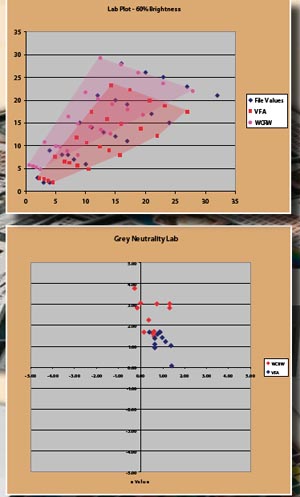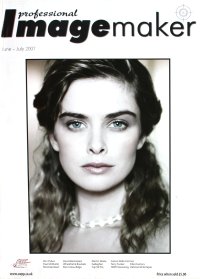articles/Paper/artexpression-page1
Paper Chase - Hahnemuhle - The Art of Expression - part 1 of 1 2 3 4 5 6 7 8 9 10 11 12 13 14
by Mike McNamee Published 01/06/2007

It is now 18 months since we tested the Hahnemuhle Lumijet paper range and almost two years since we looked at some of their other papers. Since that time they have introduced a number of new papers, reduced their range in some areas and printer technology has moved on with the arrival of the Epson 3800, the HP 2100 and 3100 and the Canon range of 12-ink printers - timely then to take another look at the range.
The main changes are the introduction of Natural Art Duo (216gsm has been upgraded to 256gsm, Photo Rag Duo (the 316 and 196 variants have been reduced to a universal 276gsm), Museum Etching 350 is introduced, Fine Art Pearl 285 is introduced as is Photo Rag
Pearl 320. Last time we reviewed, we did not run the rule over the entire ArtLine series; this time we have gone as far as print-auditing each paper and gathering statistics. The newer papers we have looked at in even more detail.

Basically, the range comprises the PhotoLine and the ArtLine, and the major characteristics are tabled. This is a comprehensive range of papers and you have to take the time to understand the options available. The papers are sold from a variety of outlets regularly advertised in Professional Imagemaker (On-line-paper, FotoSpeed, RK Photographic). There will not be a winner out of the review, all papers from this mill are outstanding quality and well respected in galleries and print publishers - you can afford to make you decision on preference, cost and decisions on the acceptability of OBAs and pulp source within your own market.
How to decide?
Faced with such an array of choice just how do you start? The most commonly found material in art galleries is probably William Turner, a mould-made material with quite a significant texture, much loved by artists. It is available as a digital material and an artist's traditional material.
At Professional Imagemaker we always recommend photographers to start with Photo Rag. This comes in several guises and weights but is excellent if you do not wish the underlying paper structure to interfere with your image. It also acts as a good springboard to other materials in the range. It is the material we use as a starting point when testing printers. The Fine Art Pearl 285 and Photo Rag Pearl 320 materials are probably the most interesting of the newcomers. The market is currently awash with 'traditional fibre base look-alike' materials and they are proving to be very popular (and very good). The Hahnemuhle Pearls are no exception, with a high Dmax, good gamut and very accurate skin tones.
In general, the papers from the ArtLine series are more textured and you need to print on them to get a feel for how they look. A sample pack is a good starting point. The Hahnemuhle website contains icc profiles for most (but not all) of the papers in their range used with 27 specific printers, approaching 500 profiles in all. They are available for PC and Mac platforms. On the Epson 3800 they produced reasonably accurate prints which were only marginally improved by bespoke profiling but bear in mind that the 3800 is proving to be a very consistent printer from model to model.
Testingpaper testing
In a comprehensive testing such as this, the methods used have to be consistent if accurate comparisons are to be made, and especially so if you wish to cross-check to data acquired as long as two years ago. The first choice to be made is the test printer. There are 37 Hahnemuhle surfaces and they show profiles for 18 possible printers for Epson, HP and Canon. This gives a starting point of 666 combinations. If you then wish to compare bespoke profiles, inbuilt profiles and those provided on the website then the combinations spiral up to 1,998, requiring about 9,990 prints. This is out of the question, which is why we had to choose one printer and a limited number of profile combinations. They were as follows:
The printer chosen was the Epson 3800, using Matte Black Ink on art or matte papers and PhotoBlack for others. The Epson 3800 makes a good printer choice because our experience testing a number of them teaches us that they are tending to come off the production line with very similar characteristics, essential if you wish to use generic profiles. Printer conditions were High Speed ON, Black Point Compensation OFF, rendering intent Perceptual and resolution set to 2880dpi. We note that the Hahnemuhle recommendations are for 2880dpi but are mindful that the 3800 performs substantially in the same way at different resolutions unlike its cousins - we also hold the view that, if a print is worthy of an expensive piece of Hahnemuhle Fine Art paper, then it is worth waiting a little longer for a highresolution print!
You are currently on page 1
- Paper Chase - Hahnemuhle - The Art of Expression page 1
- Paper Chase - Hahnemuhle - The Art of Expression page 2
- Paper Chase - Hahnemuhle - The Art of Expression page 3
- Paper Chase - Hahnemuhle - The Art of Expression page 4
- Paper Chase - Hahnemuhle - The Art of Expression page 5
- Paper Chase - Hahnemuhle - The Art of Expression page 6
- Paper Chase - Hahnemuhle - The Art of Expression page 7
- Paper Chase - Hahnemuhle - The Art of Expression page 8
- Paper Chase - Hahnemuhle - The Art of Expression page 9
- Paper Chase - Hahnemuhle - The Art of Expression page 10
- Paper Chase - Hahnemuhle - The Art of Expression page 11
- Paper Chase - Hahnemuhle - The Art of Expression page 12
- Paper Chase - Hahnemuhle - The Art of Expression page 13
- Paper Chase - Hahnemuhle - The Art of Expression page 14
1st Published 01/06/2007
last update 09/12/2022 14:51:13
More Paper Articles
There are 0 days to get ready for The Society of Photographers Convention and Trade Show at The Novotel London West, Hammersmith ...
which starts on Wednesday 14th January 2026





